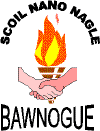

The following has been taken from the Dept. of Education & Science Guidelines for Parents.
Primary School Curriculum (1999)
The most striking feature of Curaclam na Bunscoile (1971) was that it put the child at the centre of the learning process. It was a child-centred curriculum.
The Primary School Curriculum (1999) retains this essential feature but it concentrates on the child as a learner. It sets out in great detail what the child should learn and how the child can learn it most effectively. It also places great emphasis on inspiring in children a love of learning and on helping them to develop the ability to learn throughout their lives.
Active learning gives children a deeper understanding of what is learned and helps them to remember it. Success in learning gives children a feeling of achievement, raises their confidence and self-esteem and fosters in them an enthusiasm for further learning. They learn best when they are actively involved in learning, that is, taking part in interesting and stimulating activities.
All the subjects of the curriculum encourage active learning experiences for children that will make learning interesting, enjoyable and fulfilling.
What does the curriculum emphasise?
The individual child. No two children are alike. The curriculum emphasises and encourages the individuality of every child, including children with special educational needs.
Skills. Skills are developed in every subject. These include, for example, the skill needed in music to play a simple tune or, in reading, the skill of associating certain groups of letters with certain sounds.
Developing concepts. In the course of gaining knowledge, children are helped to develop concepts, that is, general ideas or notions. This helps them to link related pieces of knowledge. For example, in mathematics children learn the concept that multiplication is the same as repeated addition (4 x 3 is the same as 4 + 4 + 4).
Different ways of learning. Children learn in different ways The curriculum recommends a great variety of approaches and methodologies which will suit varying learning styles. In addition, it suggests different forms of classroom organisation, for example, whole-class teaching, learning in groups and learning in pairs.
Working together to learn. The teacher will work with children in encouraging and guiding their learning, but children will also learn through working with each other. Children are stimulated by hearing the ideas and opinions of others and by having the opportunity to react to them. This will help to broaden and deepen an individual child's understanding. Moreover, the experience of working together helps the child's social and personal development.
The importance of language. As well as learning languages such as English and Irish, children learn through language. In other words by learning new words and phrases children learn new concepts and ideas. For example, to a young child the word "sister" means a particular member of the family. Later the child will come to realise that there is such a thing as a sister and later still that the word has many other meanings, such as sister - nurse, sister - a nun, sister-in-law, sisterhood and so on. This is a very simple example of how a child learns through language. Talk and discussion and the use of language are seen as essential to learning in every curriculum area.
Literacy and numeracy. Literacy, that is, the ability to read and write and numeracy, the ability to understand and use numbers, are essential for effective learning and vital for success in life. The development of literacy skills is a fundamental aim of the approach to reading and enabling the child to understand and use number is a fundamental aim of the mathematics curriculum
The environment. Children's own environment, that is, their immediate world, is real and familiar to them. Learning is more meaningful and effective when children can relate it to what they have experienced and know well. For example, in the course of investigating the local environment in geography, children might examine a stream, noting, among other things, its width, the depth and speed of the water and the vegetation on the banks
Hands on experience. Using and handling materials such as counters and beads in mathematics, or tools and implements from the past in history, help children to root their understanding of things in practical experience.
An integrated curriculum. Children are encouraged to make connections and links between what they learn in the different subjects and curriculum areas. For example, measuring temperature in geography, where temperatures above and below freezing point are recorded, is linked to positive and negative numbers in mathematics.
Assessment. Assessment is seen as an essential part of teaching and learning and the importance of giving parents a clear idea of their children's progress is emphasised.
Information and Communication Technologies (ICT). Information and communication technologies are an important part of living and working in the modern world. ICT, particularly computers, can make an important contribution to successful learning.